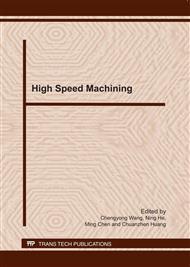p.352
p.356
p.360
p.364
p.368
p.372
p.376
p.381
p.387
Finite Element Method Modeling Approaches in Grinding
Abstract:
In the present paper, a three-dimensional finite element model was used for simulating the grinding force at different cutting conditions. The effects of the wheel speed, feed and grinding depth on the grinding force per unit width were analyzed in detail. The results show that both the normal force and tangential force increase linearly with the increasing of feed and grinding depth, however, with the increasing of wheel speed, the grinding force decreases gradually. The predicted normal and tangential grinding forces were compared with those experimentally obtained and the results show reasonable agreement quantitatively.
Info:
Periodical:
Pages:
368-371
Citation:
Online since:
March 2011
Authors:
Keywords:
Price:
Сopyright:
© 2011 Trans Tech Publications Ltd. All Rights Reserved
Share:
Citation:


